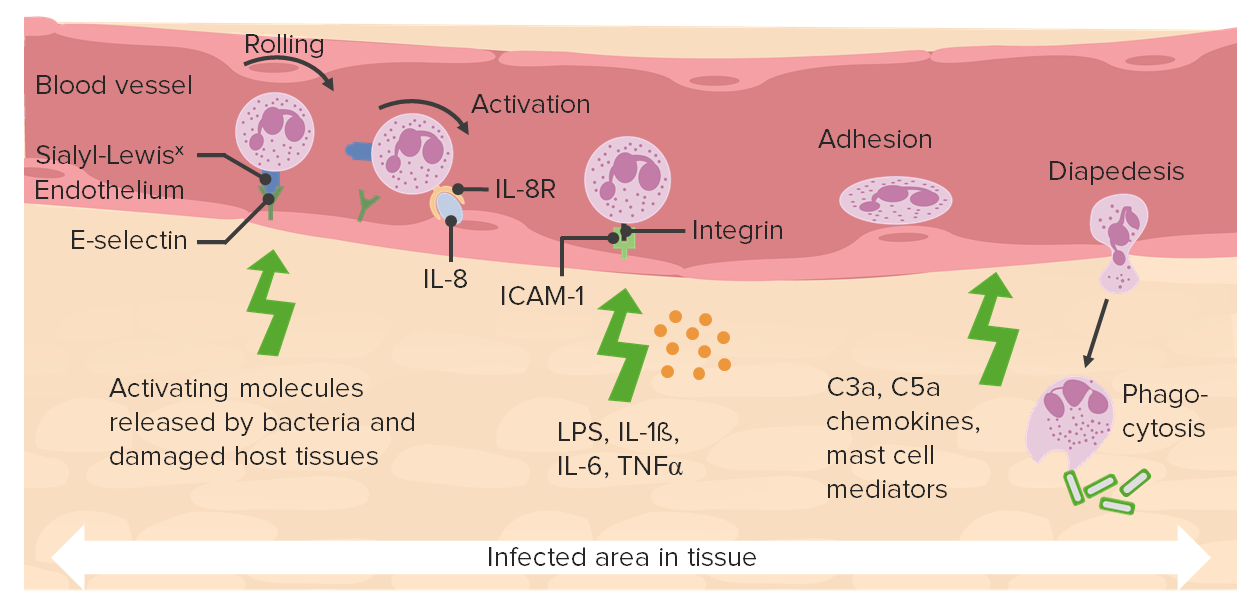Playlist
Show Playlist
Hide Playlist
Neutrophil Transmigration
-
Slides Acute and Chronic Inflammation Cellular response.pdf
-
Reference List Pathology.pdf
-
Download Lecture Overview
00:01 Neutrophils now once they have had firm adhesion through those integrins that have been activated because of chemokines, they now will need to crawl across. 00:11 So that's the transmigration. It's also called diapedesis. 00:15 It will involve some additional molecules. 00:18 So what happens in diapedesis or transmigration? Here we have the endothelial cell on the bottom. 00:25 And on top of it, the leukocyte. 00:27 The neutrophil, firmly adherent. 00:29 And it's looking for a place to go across. 00:32 Well, in fact, it's a dynamic dance between the leukocyte and the endothelial cell that allows this transmigration to happen. 00:39 The leukocyte when it's firmly adherent induces an intracellular calcium signal. 00:44 That intracellular calcium signal will then take preformed vesicles that contained within them a molecule called PCAM. 00:55 We've already talked about PCAM. 00:57 The platelet endothelial cell adhesion molecule or CD31. 01:03 And it will translocate that preformed vesicle and the endothelium into the space between two endothelial cells. 01:11 Think about it. 01:12 A leukocyte going through is not only going to need kind of a path to follow. 01:17 but the cells need to make room for this. 01:19 The endothelial cells need to have more space to accommodate this big cell that's coming across. 01:26 So that membrane coming from the vesicular compartment allows greater space. 01:31 And PECAM gets expressed now in the space between the leukocyte and the endothelium. 01:38 And we now have a homotypic interaction. 01:42 Leukocytes also express CD31. 01:45 And they will bind to PECAM, CD31 on the endothelial cells. 01:49 And that will help draw them through. 01:52 CD99 is another molecule that's involved in the process. 01:57 And everything is being driven by that wonderful perfume of the chemokine saying, "Come here, come here, come across this endothelial layer." So the diapedesis or transmigration is driven by the chemokines, that perfume. 02:14 It requires endothelial and leukocyte cells cytoskeleton rearrangement. 02:19 We have to dramatically change the way that the neutrophil crawls across. 02:23 We also have to dramatically changed the endothelium to accommodate that. 02:28 It's driven or the adhesion molecules involved are CD31, which is PECAM. 02:33 It's an immunoglobulin-superfamily. 02:35 and it's homotypic interactions. 02:37 CD31 on one cell, and CD31 on the other cell, binding to each other. 02:43 Other molecules are involved, that's the CD99. 02:46 And the reason that we care about these is that we have specific ways to block this. 02:51 So we may be able to modulate inflammation by having inhibitors of CD31 or CD99. 03:00 Typically, but also the leukocytes don't go across cells, they go between cells. 03:05 Okay, so that's the process of getting there. 03:08 And now, once they are there, we have to get them to actually the bugs. 03:14 We have to lead them kind of by the nose so that they can find the area of injury or the pathogens that have caused the injury.
About the Lecture
The lecture Neutrophil Transmigration by Richard Mitchell, MD, PhD is from the course Acute and Chronic Inflammation.
Included Quiz Questions
Which of the following mediates the leukocyte-endothelial cell interactions during diapedesis?
- (PECAM) - (PECAM) interactions
- (PECAM) - (LFA-1) interactions
- (PECAM) - (Sialyl-LewisX) interactions
- (ICAM-1) - (LFA-1) interactions
- (P-selectin) - (Sialyl-LewisX) interactions
Which of the following best describes diapedesis?
- Paracellular transmigration
- Migration through the interstitium to the site of injury
- Integrin-mediated process
- TGF-β-dependent process
- Cleavage of the tight junction by metalloproteases
Customer reviews
5,0 of 5 stars
| 5 Stars |
|
5 |
| 4 Stars |
|
0 |
| 3 Stars |
|
0 |
| 2 Stars |
|
0 |
| 1 Star |
|
0 |




